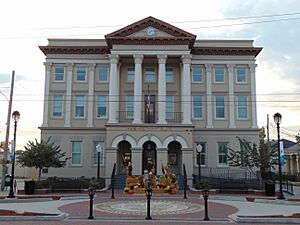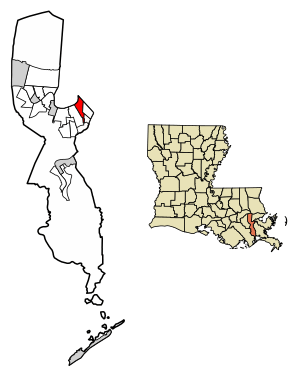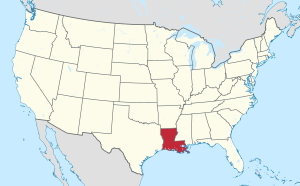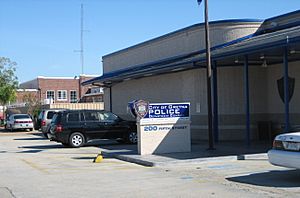Gretna, Louisiana facts for kids
Quick facts for kids
Gretna, Louisiana
|
||
|---|---|---|
| City of Gretna | ||

Gretna City Hall
|
||
|
||

Location of Gretna in Jefferson Parish, Louisiana.
|
||

Location of Louisiana in the United States
|
||
| Country | United States | |
| State | Louisiana | |
| Parish | Jefferson | |
| Area | ||
| • Total | 4.50 sq mi (11.64 km2) | |
| • Land | 4.04 sq mi (10.45 km2) | |
| • Water | 0.46 sq mi (1.19 km2) | |
| Elevation | 0 ft (0 m) | |
| Population
(2020)
|
||
| • Total | 17,814 | |
| • Rank | JE: 2nd | |
| • Density | 4,413.78/sq mi (1,704.37/km2) | |
| Time zone | UTC-6 (CST) | |
| • Summer (DST) | UTC-5 (CDT) | |
| ZIP codes |
70053, 70054, 70056
|
|
| Area code(s) | 504 | |
| FIPS code | 22-31915 | |
| GNIS feature ID | 2403761 | |
Gretna is a city in Louisiana, a state in the United States. It is the second-largest city in Jefferson Parish. Gretna is also the "parish seat," which means it's where the main government offices for the parish are located.
The city sits on the west side of the Mississippi River. It's right across the river from uptown New Orleans. Gretna is part of the larger New Orleans metropolitan area. In 2020, about 17,814 people lived there.
Contents
Discovering Gretna's Past
Gretna's story began around 1750 with a large farm called a plantation. This plantation was owned by Jean-Charles de Pradel. Later, in 1813, the land was bought by John McDonogh.
In 1815, McDonogh started a new settlement. He divided his land into smaller parts for homes and farms. This area became known as McDonoghville. It was the very first planned community in Jefferson Parish.
Gretna itself was settled in 1836. It was first called Mechanikham. The city grew because it was a train station on the Mississippi River. Trains like the Missouri Pacific and Southern Pacific stopped here. People could also take a ferry across the river to New Orleans.
A famous food company, Zatarain's, moved to Gretna in 1963. They make spices and other food products. Gretna officially became a city in 1913. It included parts of McDonoghville when it was incorporated.
Gretna's Location and Landscape
Gretna is very close to sea level. It sits at about 0 feet (0 meters) above sea level. The city is protected by a levee along the Mississippi River. A levee is a wall built to prevent floods.
The city covers a total area of about 3.9 square miles (10.1 square kilometers). Most of this area is land, about 3.5 square miles (9.1 square kilometers). The rest, about 0.4 square miles (1.0 square kilometer), is water.
Who Lives in Gretna?
Gretna has grown a lot over the years. In 1850, only 717 people lived there. By 2020, the population had grown to 17,814 people.
The city is a mix of many different cultures and backgrounds. In 2020, about 41% of the people were non-Hispanic White. About 33% were Black or African American. There were also people who identified as Native American, Asian, and Pacific Islander.
A growing number of people in Gretna are of Hispanic or Latino heritage. In 2020, about 18.7% of the population was Hispanic or Latino. This shows how diverse Gretna has become.
Most households in Gretna have about 2.4 people. The average family size is about 3.06 people. In 2010, about 27.7% of households had children under 18 living there.
The median age in Gretna in 2010 was 36 years old. This means half the people were older than 36 and half were younger.
Learning and Libraries in Gretna
Public Schools in Gretna
The public schools in Gretna are managed by the Jefferson Parish Public Schools system. Students in Gretna attend different schools based on where they live.
For elementary school, students might go to Shirley T. Johnson Gretna Park Elementary, William Hart Elementary, or McDonogh #26 Elementary. Some students also go to George Cox Elementary, which is nearby.
Most middle school students attend Marrero Middle School or Livaudais Middle School. For high school, many students go to West Jefferson High School or John Ehret High School. Gretna also has the Gretna Academy for advanced studies.
Magnet and Charter Schools
Gretna has special schools called magnet schools. These include Gretna #2 Academy for Advanced Studies, which is for Pre-K to 5th grade. L. W. Ruppel Academy is a French immersion magnet school for Pre-K to 8th grade. Thomas Jefferson High School is another magnet school in Gretna.
There is also a charter school in Gretna called Milestone Sabis Academy. It serves students from kindergarten to 8th grade. Arden Cahill Academy is a private school option in Gretna.
Gretna Public Library
The Jefferson Parish Library system runs the Gretna Public Library. The current library building opened in 2010. It is a large space, perfect for reading and learning. It even has a meeting room for events.
Gretna's Culture and Heritage
German American Cultural Center
Gretna is home to the German American Cultural Center (GACC). This center was started in 1988. Its goal is to share the history of German immigrants in Louisiana.
The GACC offers exhibits, talks, and other programs. They also host fun events like Maifest and Oktoberfest. Oktoberfest is a popular three-day event held every October.
Famous People from Gretna
Many interesting people have connections to Gretna. Here are a few:
- Bianca Del Rio (born Roy Haylock, 1975), a famous actor and drag queen.
- Joseph Cao (b. 1967), a lawyer and former U.S. Representative.
- Joe Clay (1938-2016), a rockabilly musician.
- Frankie Ford (1939-2015), a rock and roll singer.
- John Fourcade (b. 1960), a former quarterback for the New Orleans Saints.
- Emmett Hardy (1903-1925), an early jazz musician.
- Eddie Lacy, a former running back for the Green Bay Packers.
- Lash LaRue (1917-1996), a Western film actor.
- John McDonogh (1799-1850), a businessman who helped found McDonoghville.
- Greg Monroe, an NBA basketball player.
- Mel Ott (1909–1958), a famous baseball player in the Hall of Fame.
- Elfrid Payton, Jr., a professional basketball player.
- Ike Taylor, a retired football player for the Pittsburgh Steelers.
See also
 In Spanish: Gretna (Luisiana) para niños
In Spanish: Gretna (Luisiana) para niños



